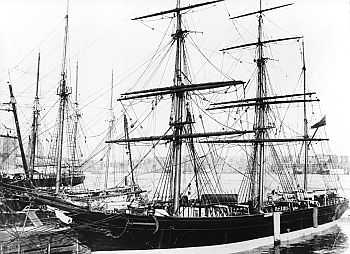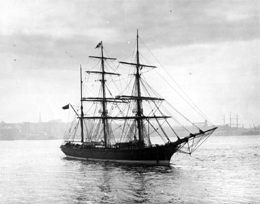We take this opportunity to thank Alice Austen, as without her love of photography and her brilliant photographic record of New York Harbour, we would have found it virtually impossible to restore James Craig to original detail. It is because of her breathtaking photographs of James Craig in New York Harbour that we have been able to keep so much detail authentic.
From the lawn of her Staten Island home “Clear Comfort”, overlooking the Verrazano Narrows at the entrance to New York Harbor. Alice Austen observed and photographed the dynamic life of this great seaport, bequeathing to us a priceless record of square riggers, coasting schooners, racing yachts, tugboats, excursion steamers, immigrant ships and ocean liners in the late 1800s and early 1900s. Today, that home is a museum, overshadowed by the Verrazano Narrows Bridge, but still witness to the commercial and recreational traffic that makes the harbor one of the world’s pre-eminent seaports.
Young Alice was only ten years old in 1876 when she got her hands on her first camera, loaned to her by her Danish sea-captain uncle, Oswald Muller. She took to the medium immediately and soon became a skilled photographer with an artist’s eye for composition and light and a scientist’s understanding of the new technology. She was a pioneer in the new field of photography, capturing places, people and events that no one else, man or woman, was recording. Her home, family, friends and New York harbor were her first subjects, but she soon took her craft out into the wider world, to tennis courts and race tracks, to quarantine stations like Hoffman and Swinburne islands, to South Street where the great ships berthed, to the busy streets of Lower Manhattan, and on her travels up and down the East Coast, to the Chicago World’s Fair and to Europe.
Born into a wealthy Staten Island family and raised as the only child in a household with six adults – her mother (Alice’s father had deserted his family, possibly before Alice was born), her grandparents, her mother’s siblings Mary and Peter, and Mary’s husband Oswald – Alice had the leisure to explore her newfound interest and the funds to pay for expensive equipment.
In that era, photography was not a hobby you could pick up on a whim. Expense was not the only consideration. The cameras when owned were heavy, cumbersome instruments that required a tripod to hold the camera steady for several seconds needed to take the picture. The images were made on glass plates, which she had to carry with her – one for every shot she planned. She then took the plates home and processed them in her own closet-like darkroom on the second floor of the house. Because there was no running water in the house for most of her life, she took the plates out to the pump to be rinsed in all weather.
Composing the photograph, evaluating the natural lighting, the optimal exposure time, the amounts of the dangerous magnesium flash powder needed to illuminate an indoor scene and the correct methods of processing the plates made up a challenging combination of art and science. Alice more than met that challenge. Throughout her life she experimented constantly with her art and she recorded her experiments meticulously on the sleeves that held each plate, listing the date, subject, weather, time, location, camera and lens used, the exposure time and other assorted details. A typical entry reads “Wisteria taken from window upstairs. No sun, but not far away. A sort of Indian summer day, glimmering, 2.40pm. May 21st, 1914. Stanley Ortho. Counted 20. Azo Hard G Matte.”
Amateur only in that she did not get paid for her craft, she energetically pursued photography until arthritis made it too difficult for her to manipulate the camera. It is estimated that she took some 7,000 photographs in her lifetime. Of those, 3,500 or so survive in the Staten Island Historical Society, rescued by chance. Few of these had been seen by any but family and friends. Austen did get copyrights on about 150 images, some of which became postcards. Another series of photographs of men, women and children on the streets of Lower Manhattan were part of a series entitled “New York Street Types” which were mounted and sold in a folder tied with a silk ribbon. In the mid-1890’s she took photographs to illustrate a book on bicycling for ladies for her friend Violet Ward, which gave her an opportunity to further her experiments photographing people and objects in motion, a challenge she wrestled with throughout her photographic career.
After the stock market crash in 1929, Alice Austen’s life changed dramatically. Throughout her younger years she had not had financial worries and her social position in Staten Island, as well as the force of her personality, made her a person of influence in her community. However, with the loss of her money at the age of 63, life became difficult. She had never married and had stayed at “Clear Comfort” after her family passed away. She lived there with her friend Gertrude Tate for 16 more years, trying to keep her home and possessions together. Gertrude ran a dancing school for years and the two ladies opened an unsuccessful tea room in their house for several summers. Finally, in 1945, they were forced out. After several increasingly traumatic moves, Austen signed a statement acknowledging herself a pauper and was given a bed in the Staten Island Farm Colony, basically a poor house, where she would have ended her days had she not been found by Oliver Jensen, a former editor at Life who would go on to found the American Heritage Publishing Company.
In 1951, Jensen was looking for photographs by women for his book The Revolt of American Women. The Staten Island Historical Society brought Alice Austen’s photographs to his attention. Jensen was highly impressed with the skill of the photographer and the social history recorded in the collection and was astounded and delighted to discover that she was still alive. When he found her, she was unresponsive until he showed her prints made from her glass plates. She gradually came out of her withdrawal to tell him the stories behind the people, places and events in the photographs. Jensen managed to get her photographs published in several magazines, raising over $4000. Austen’s share of this was sufficient to move her out of the poor house and into a comfortable, private room in a nearby nursing home. She died in June 1952, after having enjoyed a few brief months of fame for her remarkable photographs of her world.
It was a sad ending to what had been a happy and full life. By all accounts, Alice had been possessed of a lively intelligence, great curiosity, a sense of fun, a formidable talent for organising, and considerable charm and stubbornness – great assets when trying to get friends, family and strangers to pose at length for photographs that had to meet her exacting standards. Lawn tennis, golf, swimming, sailing, bicycling, parties, dances, gardening, social organisations and travel in the US and abroad – Alice Austen participated fully in the activities available to one of her position, but she was also always an observer by virtue of her chosen medium.
While many of her photographs are of family and friends, she explored farther afield than most women of her era would, or could, have gone. She seems as comfortable in commercial and industrial surroundings as she was at home or on a tennis court. In Boston she took a photograph from aboard a fishing schooner at the dock; in Annapolis a line of African-Americans posed for her in an oyster-shucking house; in Hoboken she spent hours climbing through the ruins of a recently burned block of houses.
Immigration was a subject that fascinated her. The ships bringing Europeans to New York passed by her windows every day, and the quarantine station was nearby. She was frequently at Hoffman and Swinburne islands and one of her quasi-professional jobs was on the quarantine ship James Wadsworth, as it went out to disinfect a ship suspected of carrying yellow fever. When in Manhattan, she photographed new arrivals, as well as immigrants in their neighborhoods.
Unlike other photographers who took their craft to poor neighborhoods, Austen was not looking for the seamy underbelly of New York City. Her subjects, for the most part, appear healthy, friendly and interested in the world around them. Barefoot children selling newspapers look cheeky, not downtrodden, immigrant women at the market seem to be stopped in mid-converstation, a cheerful policeman proudly presents his profile for the camera and fishermen pause in the midst of a business deal to face the photographer. Some of these photographs were taken in South Street, surely one of the least likely places in New York to find a well-bred young lady.
Elsewhere on New York’s waterfronts she captured sailors taking wood from the hull of a wrecked sailing ship, passengers aboard the ferry, a shadfishing station just north of her house, Sea Witch at a South Street pier, naval parades, yacht races, and the never ending flow of traffic that passed by her window. An avid sailor herself, she captured some of the most famous yachts in history including the races for the America’s Cup between Puritan and Generation in 1885 and Valkyrie and Vigilante in 1893.
Jensen recalls Alice Austen telling him that she was such a determined and untiring photographer in part because she realised the world she knew was vanishing, and she wanted to preserve some part of it for the future. That goal she certainly accomplished. New York Harbour had a talented and artistic champion in Alice Austen and she indeed left us with an incomparable record of our seafaring past from a unique perspective.

